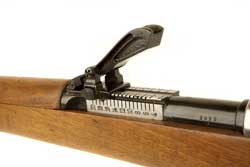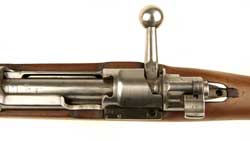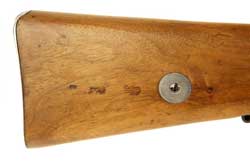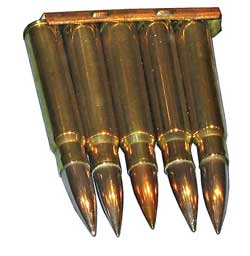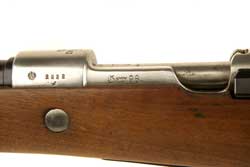| Remington Brand | Browning Brand | Winchester Brand | Mauser Gun |
Mauser Gew 98Characteristics:Type: bolt-action. Caliber(s): M/88 until 1905, 7.92×57mm Mauser/8×57mm IS later Weight unloaded: 4.09 kg. Barrel length: 740 mm. 1,250 mm. Magazine capacity: 5 rounds.
Info Mauser Gew 98The Gewehr 98 (abbreviated G98, Gew 98 or M98) is a German bolt action Mauser rifle firing cartridges from a 5 round internal clip-loaded magazine that was the German service rifle from 1898 to 1935, when it was replaced by the Karabiner 98k. It was hence the main rifle of the German infantry during World War I. The Gewehr 98 replaced the earlier Gewehr 1888 rifle as the German service rifle. The Gewehr 98, named for 1898, the first year of its manufacture, superseded the earlier Gewehr 1888 in German service. The bolt-action design used for the Gewehr 98 was patented by Paul Mauser on 9 September 1895. The Gewehr 98 itself was the latest in a line of Mauser rifles that were introduced in the 1890s. The German Gewehr-Prüfungskommission (G.P.K.) (Rifle Testing Commission) adopted the Gewehr 98 on 5 April 1898. The action was derived from the experimental Gewehr 96 Rifle. In 1901, the first troop issues of the Gewehr 98 Rifles were made to the East Asian Expeditionary Force, the Navy and three premier Prussian army corps. The Gewehr 98 received its first combat use in the Boxer Rebellion (1898–1901). In 1904, contracts were placed with Waffenfabrik Mauser for 290,000 rifles and Deutsche Waffen und Munitionsfabriken (DWM) for 210,000 rifles. In 1905, the 8 mm M/88 cartridge which was introduced in 1888 and loaded with a 8.08 mm (.318 in) 14.6 g (226 gr) round nose bullet was replaced by the 7.92×57mm Mauser which was loaded with a new 8.20 mm (.323 in) 9.9 g (154 gr) spitzer bullet. The ammunition conversion was indicated by a small "S" stamped above the chamber and on the barrel at the back of the rear sight base. This was done since the 1888 pattern M/88 cartridge and 1905 S-bore pattern cartridge are two different non interchangeable chamberings. Since the new IS cartridge had a flatter trajectory the Lange Visier rear sight had to be changed with an "S" adapted Lange Visier. The Gewehr 98 or model 98 (M98) rifle is a manually operated, magazine fed, controlled-feed bolt-action rifle, 1,250 mm (49 in) in length and 4.09 kg (9 lb) in weight. It has a 740 mm (29 in) long rifled barrel and carries 5 rounds ammunition in an internal magazine. The Gewehr 98 has two sling swivels, open front sights, and a curved tangent-type rear sight, known as the Lange Visier.The controlled-feed bolt-action of the Gewehr 98 is a distinct feature and is regarded as one of the major bolt-action system designs. The controlled-feed Mauser M98 bolt-action system is a simple, strong, safe, and well-thought-out design that inspired other military and hunting/sporting rifle designs that became available during the 20th century. A drawback of the M98 system is that it can not be cheaply mass produced very easily. Some other bolt-action designs (e.g. the Lee Enfield) offer trained operators a slightly faster rate of fire. The M98 system[3] consists of a receiver that serves as the systems shroud and a bolt group of which the bolt body has three locking lugs, two large main lugs at the bolt head and a third safety lug at the rear of the bolt which serves as a backup in case the primary locking lugs failed. This third lug is a distinctive feature and was not present on previous Mauser bolt-action designs. The two main locking lugs display a locking surface of 56 mm², whilst the third safety lug normally plays no part in locking the action to avoid asymmetric and hence unbalanced bolt thrust forces. The diameter of the receiver was also enlarged compared to previous Mauser receivers for additional strength and safety. The bolt handle is permanently attached to the bolt and on the Gewehr 98 is straight and protrudes out. Another distinctive feature of the M98 system is the controlled-feed mechanism, consisting of a large, non-rotating claw extractor that engages the cartridge case rim as soon as the round leaves the magazine and firmly holds the cartridge case until the round is ejected by the ejector, mounted inside the receiver. Combined with a slight bolt retraction at the last stage of the bolt opening cycle, caused by the cammed surface on the rear receiver bridge, this results in a positive cartridge case extraction. The M98 bolt-action will cycle correctly irrespective of the way the rifle is moved or positioned during the bolt cycling action or if the cartridge has been fired or not. Only if the bolt is not brought back far enough, sharply enough, in a controlled round feed bolt-action the cartridge case may not be cleanly ejected and a jam may result. A cartridge that is directly loaded into the chamber instead of out of the magazine will not be engaged by the claw extractor. The bolt houses the firing pin mechanism that gets cocked when the bolt is opened and the cocking piece protrudes visually and tactilely from the rear of the bolt to indicate the action is cocked. This bolt sleeve lock was not present on previous Mauser bolt-action designs and reduced firing pin travel and lock time. The action features two large gas relief holes and a gas shield on the bolt sleeve designed to protect the users head in case of a primer or cartridge rupture or detonation. When the action suffers a catastrophic failure these safety features deflect escaping gas and eventual debris away from the operator's face. The M 98 bolt group can be easily removed from the receiver simply by pulling out the bolt stop, located at the left wall of the receiver, and then by rotating and pulling the bolt out. The metal disc inlay in the rifle stock functions as a bolt disassembly tool. The metal parts of the rifle were blued, a process in which steel is partially protected against rust by a layer of magnetite (Fe3O4). Such a thin black oxide layer provides minimal protection against rust or corrosion, unless also treated with a water-displacing oil to reduce wetting and galvanic corrosion. A three-position safety attached at the rear of the bolt which operating lever can be flicked from right (safety on, bolt locked) to middle (safety on, bolt can be opened for reloading), to left (ready to fire) but only when the rifle is cocked, otherwise the safety will not move. The safety secures the firing pin. The safety can only be released by firing the rifle with the safety set in the ready to fire position or by closing the cocked bolt with a previously pulled trigger that must be kept pulled back during the closing operation. Disengaging the safety by closing the bolt is only possible with the safety set in the ready to fire position. The safety catch lever is quite large, making it easy to operate but posing a problem for mounting telescopic sights low above the receiver whilst retaining good operability of the safety catch lever. The internal magazine of the M 98 system consists of an integral box machined to match the cartridge for which the rifle was being chambered, with a detachable floorplate, that can hold up to 5 rifle cartridges. The German military M 98 system internal magazine boxes feature an internal magazine length of 84.4 mm (3.32 in) to store 82 mm (3.23 in) maximal overall length 7.92x57mm Mauser cartridges without dimensional issues. The cartridges are stored in the magazine box in a staggered column at a stacking angle of 30 degrees, so viewed from the end, three cartridges touching each other form the points of an equilateral triangle. The magazine can be loaded with single rounds by pushing the cartridges into the receiver top opening or via stripper clips. Each stripper clip can hold 5 rounds to fill the magazine and is inserted into clip guides machined into the rear receiver bridge. After loading the empty clip is ejected when the bolt is closed. The magazine can be unloaded by operating the bolt (the safe ty should for safety reasons be set to the middle position for this) or in case of mechanical problems by opening the magazine floorplate, which is flush with the stock, with the help of a cartridge tip. Though the production of the M98 system for the German military ceased at the end of World War II in 1945, the production of new Mauser M 98 and Mauser M 98 Magnum rifles for civil users has been resumed in 1999 by Mauser Jagdwaffen GmbH[5] (Mauser Huntingweapons Ltd.), according to original drawings of 1936 and the respective Mauser patents. These rifles retail (2009) for approximately EUR 6,800 for the basic Mauser M 98 version, but the addition of (luxury) options can make these rifles much more expensive. Several other gun manufactures and custom gun builders also currently produce new M98 system clones or M98 inspired bolt-action hunting/sporting rifles. Many Mauser M98 inspired derivatives feature technical alterations to simplify production. The rifle had a two-stage trigger with considerable take up before the trigger engages the sear. This feature aids in preventing premature firing during stressful (combat) situations. Originally the Gewehr 98 sight line had an open post type front sight, and a curved tangent-type rear sight with a V-shaped rear notch, known as the Lange Visier. The rear sight was graduated for 1888 pattern M/88 cartridges from 300 m to 2000 m in 100 m increments. The M/88 cartridge was loaded with full metal jacket projectiles of the round-nosed type. The standard open iron sight aiming elements consisted of relatively coarse rugged aiming elements making the sightline suitable for rough handling and low light usage, but less suitable for aiming at small point targets. The sights were designed with distant area fire targets like charging horseman units in mind, so the standard iron sight line could be calibrated for very long ranges. Military doctrine in the late 19th and early 20th century considered firing at distant area targets, where an officer would call out the range and the soldiers shot in volley, normal. Later the Gewehr 98 sight line was modified for 1905 pattern 8x57mm IS cartridges. The 7.9 mm S bullet was lighter, pointed, and 8.2 mm (.323 inches) in diameter instead of 8.08 mm (.318 inches) with an improved ballistic coefficient. The new IS cartridge had a flatter trajectory, and was therefore somewhat less critical of range estimation. With the introduction of the 8x57mm IS ammunition the rear sight graduation was changed accordingly and could be regulated from 400 m (440 yd) to 2,000 m (2,200 yd) in 100 m (110 yd) increments. Interestingly, while the modified sight line for 7.92×57mm Mauser IS cartridges was calibrated for a minimal zero distance of 400 m (440 yd) and can result in hitting high when using the open post front sight and V-shaped rear notch at close range, the pillars formed by the tracks of the rear sight allow closer targets to be quickly bracketed between the "goalposts", a sighting method that automatically compensates for the high point of aim using the normal sighting method. The Gewehr 98 oil finished rifle stock features a semi-pistol grip. A top handguard was standard on all rifles and extended from the front of the rear sight base terminating just ahead of the bottom barrel band. A steel cross bolt was mounted to distribute the forces and hence the effects of recoil on the stock bedding, reducing the chance to split the stock. The stock featured a quick detachable sling swivel on the underside of the butt stock, a top swivel located underneath the bottom barrel band and a parade hook mounted on the underside of the top H-style barrel band. The prewar stocks were produced from walnut wood and were aged for an average of three years to allow the wood to stabilize. Beginning in 1917, walnut shortages necessitated the use of beech wood. The late war production beech stocks were less durable and heavier than the original walnut stocks. The rifle was issued with a leather carrying sling. During the duration of World War I, due to a shortage of leather, slings were produced out of canvas[citation needed]. The rifle was able to fire rifle grenades. Various attachable rifle grenade launcher models were designed during World War I. The Gewehr 98 was designed to be used with a bayonet.[6] For this the rifle had a H-style top barrel-band with a 4.5 cm (1.8 in) long bayonet lug. The long bearing surface on the Gewehr 98 eliminated the addition of a muzzle ring. The advantage of this solution lies in the fact that muzzle rings can interfere with barrel oscillation which can significantly impede the accuracy of a rifle. The rifle was originally issued with the Seitengewehr 98 pattern bayonet. This épée style bayonet has a 500 mm (19.7 in) long quillback blade. By the end of 1905, this bayonet began to be replaced with the more robust and practical Seitengewehr 98/05, with a 370 mm (14.6 in) blade. It was called the "Butcher Blade" by the Allies due to its distinctive shape, and was initially intended for artillerymen and engineers as a chopping tool as well as a weapon. Towards the end of World War I, the 250 mm (10 in) blade Seitengewehr 84/98 was introduced as an economy measure and because the longer models were impract ical in narrow trenches; this model became standard issue during the Weimar Republic and Third Reich. Serrated versions of the aforementioned patterns intended to be used as tools were carried by German Pioniere (military combat engineers). |
MAUSER HISTORI MAUSER PISTOLS
MAUSER RIFLES
BIB.GE Categories |


